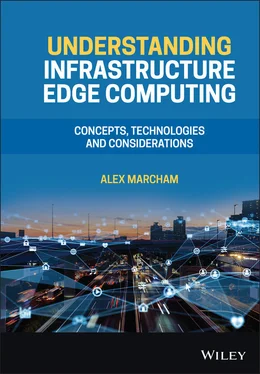Alex Marcham - Understanding Infrastructure Edge Computing
Здесь есть возможность читать онлайн «Alex Marcham - Understanding Infrastructure Edge Computing» — ознакомительный отрывок электронной книги совершенно бесплатно, а после прочтения отрывка купить полную версию. В некоторых случаях можно слушать аудио, скачать через торрент в формате fb2 и присутствует краткое содержание. Жанр: unrecognised, на английском языке. Описание произведения, (предисловие) а так же отзывы посетителей доступны на портале библиотеки ЛибКат.
- Название:Understanding Infrastructure Edge Computing
- Автор:
- Жанр:
- Год:неизвестен
- ISBN:нет данных
- Рейтинг книги:4 / 5. Голосов: 1
-
Избранное:Добавить в избранное
- Отзывы:
-
Ваша оценка:
- 80
- 1
- 2
- 3
- 4
- 5
Understanding Infrastructure Edge Computing: краткое содержание, описание и аннотация
Предлагаем к чтению аннотацию, описание, краткое содержание или предисловие (зависит от того, что написал сам автор книги «Understanding Infrastructure Edge Computing»). Если вы не нашли необходимую информацию о книге — напишите в комментариях, мы постараемся отыскать её.
Understanding Infrastructure Edge Computing
infrastructure edge computing
Understanding Infrastructure Edge Computing
Understanding Infrastructure Edge Computing — читать онлайн ознакомительный отрывок
Ниже представлен текст книги, разбитый по страницам. Система сохранения места последней прочитанной страницы, позволяет с удобством читать онлайн бесплатно книгу «Understanding Infrastructure Edge Computing», без необходимости каждый раз заново искать на чём Вы остановились. Поставьте закладку, и сможете в любой момент перейти на страницу, на которой закончили чтение.
Интервал:
Закладка:
Table of Contents
1 Cover
2 Title Page
3 Copyright Page
4 Dedication Page
5 PrefaceHow to Use This Book About This Book Audience
6 About the Author
7 Acknowledgements
8 1 Introduction
9 2 What Is Edge Computing?2.1 Overview 2.2 Defining the Terminology 2.3 Where Is the Edge? 2.4 A Brief History 2.5 Why Edge Computing? 2.6 Basic Edge Computing Operation 2.7 Summary References
10 3 Introduction to Network Technology3.1 Overview 3.2 Structure of the Internet 3.3 The OSI Model 3.4 Ethernet 3.5 IPv4 and IPv6 3.6 Routing and Switching 3.7 LAN, MAN, and WAN 3.8 Interconnection and Exchange 3.9 Fronthaul, Backhaul, and Midhaul 3.10 Last Mile or Access Networks 3.11 Network Transport and Transit 3.12 Serve Transit Fail (STF) Metric 3.13 Summary References
11 4 Introduction to Data Centre Technology4.1 Overview 4.2 Physical Size and Design 4.3 Cooling and Power Efficiency 4.4 Airflow Design 4.5 Power Distribution 4.6 Redundancy and Resiliency 4.7 Environmental Control 4.8 Data Centre Network Design 4.9 Information Technology (IT) Equipment Capacity 4.10 Data Centre Operation 4.11 Data Centre Deployment 4.12 Summary References
12 5 Infrastructure Edge Computing Networks5.1 Overview 5.2 Network Connectivity and Coverage Area 5.3 Network Topology 5.4 Transmission Medium 5.5 Scaling and Tiered Network Architecture 5.6 Other Considerations 5.7 Summary
13 6 Infrastructure Edge Data Centres6.1 Overview 6.2 Physical Size and Design 6.3 Heating and Cooling 6.4 Airflow Design 6.5 Power Distribution 6.6 Redundancy and Resiliency 6.7 Environmental Control 6.8 Data Centre Network Design 6.9 Information Technology (IT) Equipment Capacity 6.10 Data Centre Operation 6.11 Brownfield and Greenfield Sites 6.12 Summary
14 7 Interconnection and Edge Exchange7.1 Overview 7.2 Access or Last Mile Network Interconnection 7.3 Backhaul and Midhaul Network Interconnection 7.4 Internet Exchange 7.5 Edge Exchange 7.6 Interconnection Network Technology 7.7 Peering 7.8 Cloud On‐ramps 7.9 Beneficial Impact 7.10 Alternatives to Interconnection 7.11 Business Arrangements 7.12 Summary
15 8 Infrastructure Edge Computing Deployment8.1 Overview 8.2 Physical Facilities 8.3 Site Locations 8.4 Coverage Areas 8.5 Points of Interest 8.6 Codes and Regulations 8.7 Summary
16 9 Computing Systems at the Infrastructure Edge9.1 Overview 9.2 What Is Suitable? 9.3 Equipment Hardening 9.4 Rack Densification 9.5 Parallel Accelerators 9.6 Ideal Infrastructure 9.7 Adapting Legacy Infrastructure 9.8 Summary References
17 10 Multi‐tier Device, Data Centre, and Network Resources10.1 Overview 10.2 Multi‐tier Resources 10.3 Multi‐tier Applications 10.4 Core to Edge Applications 10.5 Edge to Core Applications 10.6 Infrastructure Edge and Device Edge Interoperation 10.7 Summary
18 11 Distributed Application Workload Operation11.1 Overview 11.2 Microservices 11.3 Redundancy and Resiliency 11.4 Multi‐site Operation 11.5 Workload Orchestration 11.6 Infrastructure Visibility 11.7 Summary
19 12 Infrastructure and Application Security12.1 Overview 12.2 Threat Modelling 12.3 Physical Security 12.4 Logical Security 12.5 Common Security Issues 12.6 Application Security 12.7 Security Policy 12.8 Summary
20 13 Related Technologies13.1 Overview 13.2 Multi‐access Edge Computing (MEC) 13.3 Internet of Things (IoT) and Industrial Internet of Things (IIoT) 13.4 Fog and Mist Computing 13.5 Summary Reference
21 14 Use Case Example14.1 Overview 14.2 What Is 5G? 14.3 5G at the Infrastructure Edge 14.4 Summary
22 15 Use Case Example15.1 Overview 15.2 What Is AI? 15.3 AI at the Infrastructure Edge 15.4 Summary
23 16 Use Case Example16.1 Overview 16.2 What Are Cyber‐physical Systems? 16.3 Cyber‐physical Systems at the Infrastructure Edge 16.4 Summary Reference
24 17 Use Case Example17.1 Overview 17.2 What Is Cloud Computing? 17.3 Cloud Computing at the Infrastructure Edge 17.4 Summary
25 18 Other Infrastructure Edge Computing Use Cases18.1 Overview 18.2 Near Premises Services 18.3 Video Surveillance 18.4 SD‐WAN 18.5 Security Services 18.6 Video Conferencing 18.7 Content Delivery 18.8 Other Use Cases 18.9 Summary
26 19 End to End19.1 Overview 19.2 Defining Requirements 19.3 Success Criteria 19.4 Comparing Costs 19.5 Alternative Options 19.6 Initial Deployment 19.7 Ongoing Operation 19.8 Project Conclusion 19.9 Summary
27 20 The Future of Infrastructure Edge Computing20.1 Overview 20.2 Today and Tomorrow 20.3 The Next Five Years 20.4 The Next 10 Years 20.5 Summary
28 21 Conclusion
29 Appendix A: Acronyms and Abbreviations
30 Index
31 End User License Agreement
List of Tables
1 Chapter 3 Table 3.1 OSI model layer numbers, names, and examples. Table 3.2 Example minimum acceptable and desired average STF metrics.
2 Chapter 4 Table 4.1 Uptime Institute tiers (numbers, names, and brief characteristics).
3 Chapter 6Table 6.1 Infrastructure edge data centre facility size categories and exampl...Table 6.2 Typical EXP and network capabilities of infrastructure edge data ce...Table 6.3 Example infrastructure edge data centre facility environmental cont...Table 6.4 Example average estimates for network usage per data centre facilit...
4 Chapter 7Table 7.1 Suitability of IEDC facilities for use as an EXP.
5 Chapter 9Table 9.1 Equipment suitability for IEDC facilities.
6 Chapter 16Table 16.1 Autonomy levels and the value of infrastructure edge computing.
List of Illustrations
1 Chapter 2 Figure 2.1 Infrastructure edge computing in context. Figure 2.2 Device edge computing in context. Figure 2.3 Self‐contained application operating on device. Figure 2.4 Application with access to remote data centre resources. Figure 2.5 Application with access to infrastructure edge computing resource...
2 Chapter 3 Figure 3.1 Routing process example. Figure 3.2 Routing and switching at a network boundary. Figure 3.3 LAN, MAN, and WAN networks. Figure 3.4 Fronthaul, backhaul, and midhaul networks. Figure 3.5 Last mile or access network interconnection failure. Figure 3.6 Infrastructure edge computing network providing transit services....
3 Chapter 4 Figure 4.1 Hot and cold air containment cooling system example. Figure 4.2 Traditional access, aggregation, and core layer network topology.... Figure 4.3 Leaf and spine, or Clos, network topology.
4 Chapter 5Figure 5.1 Full mesh, partial mesh, hub and spoke, ring, and tree network to...Figure 5.2 Partial mesh with distributed trees network topology.
5 Chapter 6Figure 6.1 Example deployment of size category 1 infrastructure edge data ce...Figure 6.2 Tiered infrastructure edge computing network with example STF met...Figure 6.3 Example scale comparison of infrastructure edge data centre size ...Figure 6.4 Topological hierarchy between size categories of infrastructure e...Figure 6.5 Physical hierarchy between size categories of infrastructure edge...Figure 6.6 Infrastructure edge data centre as single point of failure for ne...Figure 6.7 System resiliency example: phase one.Figure 6.8 System resiliency example: phase two.Figure 6.9 System resiliency example: phase three.
6 Chapter 7Figure 7.1 Tromboning network traffic path.Figure 7.2 Direct network traffic path.Figure 7.3 Backhaul and midhaul network interconnection.Figure 7.4 Network interconnection at two IXPs.Figure 7.5 A distributed IX utilising several physical IXPs.Figure 7.6 EX and IX comparison example.
7 Chapter 9Figure 9.1 Densified and non‐densified rack comparison example.
8 Chapter 10Figure 10.1 Resource gradient between user and RNDC.Figure 10.2 Resource gradient within infrastructure edge computing network....
9 Chapter 14Figure 14.1 Example architecture for 5G RAN deployment using infrastructure ...
Читать дальшеИнтервал:
Закладка:
Похожие книги на «Understanding Infrastructure Edge Computing»
Представляем Вашему вниманию похожие книги на «Understanding Infrastructure Edge Computing» списком для выбора. Мы отобрали схожую по названию и смыслу литературу в надежде предоставить читателям больше вариантов отыскать новые, интересные, ещё непрочитанные произведения.
Обсуждение, отзывы о книге «Understanding Infrastructure Edge Computing» и просто собственные мнения читателей. Оставьте ваши комментарии, напишите, что Вы думаете о произведении, его смысле или главных героях. Укажите что конкретно понравилось, а что нет, и почему Вы так считаете.












